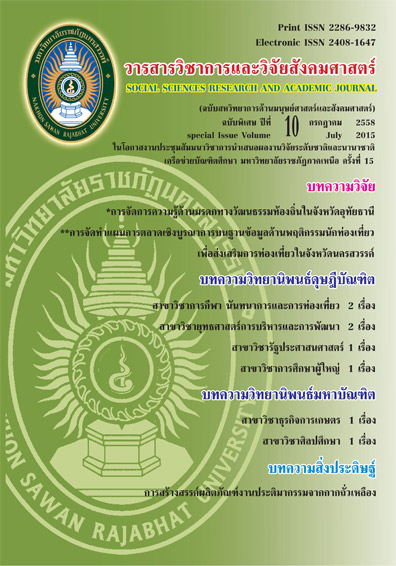นครน่านเมืองเก่าที่มีชีวิต : อัตลักษณ์ทางประวัติศาสตร์และวัฒนธรรม; Nan, the Living Old Town : The Historical and Cultural Identities
Main Article Content
Abstract
บทคัดย่อ
บทความเรื่องนี้มีวัตถุประสงค์เพื่อศึกษาอัตลักษณ์ทางประวัติศาสตร์และวัฒนธรรมของนครน่าน บทความนี้ เป็นส่วนหนึ่งของปริญญานิพนธ์ เรื่องนครน่านเมืองเก่าที่มีชีวิต : พื้นที่วัฒนธรรมและการต่อรองเชิงอัตลักษณ์ในบริบทของการท่องเที่ยวเชิงวัฒนธรรม ตามหลักสูตรปรัชญาดุษฏีบัณฑิต สาขา การกีฬา นันทนาการและการท่องเที่ยว มหาวิทยาลัยศรีนครินทรวิโรฒ
จากการศึกษาพบว่า ในบริบทของนิเวศวัฒนธรรมนั้น นครน่านมีอัตลักษณ์ทางประวัติศาสตร์มายาวนาน เกิดจากการตั้งถิ่นฐานของเมืองที่มีภูมิศาสตร์ที่ตั้งเป็นปัจจัยสำคัญและกำหนดพื้นที่ของเมืองออกจากดินแดนอื่น โดยมีภูเขาล้อมรอบอันเป็นต้นกำเนิดแม่น้ำน่านไหลผ่านประวัติศาสตร์นครน่านจึงมีความผูกพันกับสายน้ำน่านพบว่า มีการย้ายเมือง 5 ครั้ง โดยมีปัจจัยมาจากน้ำทำกินหรือภัยธรรมชาติจากน้ำ ซึ่งมีเหตุการณ์สำคัญในแต่ละยุคที่เกี่ยวข้องกับระบอบการปกครองแบบเจ้าผู้ครองนคร การทำนุบำรุงพระพุทธศาสนา และเหตุการณ์ที่เกี่ยวกับภัยธรรมชาติมาเกี่ยวข้องกับพัฒนาการทางประวัติศาสตร์ของเมือง โดยสรุปพัฒนาการทางประวัติศาสตร์ของเมืองได้ 2 ยุค คือ 1.นครน่านสมัยก่อนประวัติศาสตร์ 2.นครน่านสมัยประวัติศาสตร์ ซึ่งแบ่งได้ 4 ระยะ คือระยะที่ 1 ยุคการสร้างเมืองวรนคร-เวียงน่าน ระยะที่ 2 ยุคขึ้นกับอาณาจักรล้านนา ระยะที่ 3 ยุคตกเป็นเมืองขึ้นของพม่า ระยะที่ 4 ยุคขึ้นกับกรุงรัตนโกสินทร์ จนถึง พ.ศ.2474 เมื่อมีการยุบเลิกตำแหน่งเจ้าผู้ครองนครน่านถือเป็นการสิ้นสุดความเป็น “นครน่าน” และปรับเปลี่ยนฐานะเป็นจังหวัดหนึ่งของประเทศไทย
ส่วนอัตลักษณ์ทางวัฒนธรรมนั้น พบว่า มีบริบทการก่อเกิดวัฒนธรรมที่เป็นแบบเฉพาะของตัวเองโดยมีปัจจัยทางรัฐชาติที่เกิดจากความสัมพันธ์กับแคว้นใกล้เคียงที่มีความรุ่งเรืองกว่า เช่น สุโขทัย พุกาม ล้านนา ล้านช้าง แคว้นเหล่านี้มีอิทธิพลให้เกิดการผสมผสานทางวัฒนธรรม ศิลปะ ศาสนา จนปรากฏเป็นมรดกทางวัฒนธรรม เช่น สถาปัตยกรรมพุทธศิลป์วัดต่างๆ ที่มีความเป็นอัตลักษณ์พื้นถิ่นนครน่านโดยเฉพาะ รวมทั้ง มรดกทางวัฒนธรรมประเภทอื่นก็มีความเป็นอัตลักษณ์เฉพาะตัว เช่น ประเพณีแข่งเรือ ประเพณีที่เกี่ยวกับศาสนา งานประณีตศิลป์บนผืนผ้า อาภรณ์ รวมทั้งดนตรี-นาฏศิลป์เฉพาะถิ่นและการละเล่นที่เป็นแบบฉบับของตัวเอง เช่น ซอล่องน่าน ผ้าลายน้ำไหล เรือเอกลักษณ์หัวพญานาค เป็นต้น
Abstract
The article’s purpose was to study the historical and cultural identities of Nan city .This article is partially studied of doctoral dissertation in the field of sport, recreation and tourism. Srinakharinwirot University
This study found that there has been long history in the cultural ecology of being Nan city’s context which was the result from Nan people settlements and its geography. Being the upstream of the Nan River was affected from the complex ranges of mountain and at that time there had been found the 5 settlements of people were connected with the river in case of water supplies or other kind of natural disaster; flooding. Moreover, some important incidents were able to contribute the city’s development in different ages of the history. They were also involved with Nan’s dynasty and its monarchy, Buddhism, and natural phenomena. For political history, there were 2 ages found; 1) the pre-history age and 2) the written history age which was divided into 4 periods; the 1st period-the foundation of Woranakhon-Wiangnan, the 2nd period-being the colony of Lanna Kingdom, the 3rd period- being the colony of Burma Kingdom, the 4th period- being the colony of Rattanakosin until B.E. 1931, the cancellation of Nan monarchy happened and this was the end of Nan Dynasty. Up to now Nakhon Nan has been changed as the province in the northern Thailand.
The studies found into those 2 identities accordingly; 1) historical identity has been shown for many ages. The city settlements contributed from physical geography with mountain ranges and water streams. The city and Nan River have had a deep bond. There were 5 settlements in the past of Nan people because of water supply and natural disaster; flooding. The first settlement of Nakron Nan: Waranakron age or Muang Pua was built on the top of Phuka Mountain. The 2nd settlement was Wiang Phu Piang Chae Hang. When people became crowded and insufficient water supply, therefore, the 3rd settlement of Nakron Nan had been built; its name was Wiang Tai age (BE. 1368–1819). This city was moved because of drought. The 4th age: Wiang Nau (BE. 1819-1854) was fallen from the result of flooding in the rainy season. The final and present age (BE. 1854-present) was shifted from the 4th city since the Nan River downstream changed its direction which was far away from the defensive walls. Many important and memorable events happened in all ages involved the feudalism, Buddhism, and natural disasters and phenomena affected the changes of chronological politics incidents. 2) There were various discoveries about cultural identities; the unique contexts affected to its individual identities. The national state of Nan from more prosperous neighboring countries such as Sukhothai, Phukam, Lanna, and Lanchang influenced to be the blended art cultures and finally appeared cultural heritages in forms of Nan exclusive architectures of Thai Buddhist arts and traditional heritages e.g. boat racings, religious activities, fine painting clothes and local music instruments e.g. Sor Long Nan, Pha Lai Nam Lai, King of Nagas as a prow of a ship.

